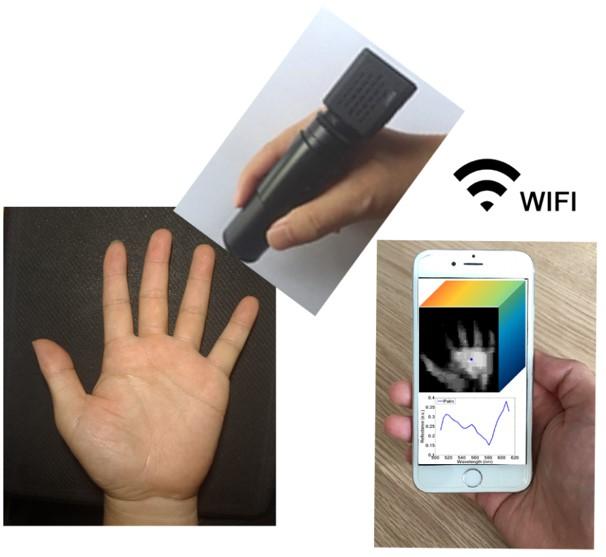
A new pencil-like wireless spectrometer can be used with a smartphone to collect 3-D spectral images of the body and other objects. This design could make the device useful for point-of-care diagnostics.
Spectral images, which contain more color information than is obtainable with a typical camera, reveal characteristics of tissue and other biological samples that can’t be seen by the naked eye. A new smartphone-compatible device that is held like a pencil could make it practical to acquire spectral images of everyday objects and may eventually be used for point-of-care medical diagnosis in remote locations.
Potential applications of the new device include detecting oxygen saturation in a person’s blood, determining the freshness of meat in the grocery store and identifying fruit that is the perfect ripeness. The spectrometer could also make it easier to acquire spectral data in the field for scientific studies.
In The Optical Society (OSA) journal Biomedical Optics Express, the researchers describe how to make the new pencil-like spectrometer and demonstrate its ability to acquire spectral images of bananas, pork and a person’s hand. The new device can detect wavelengths from 400 to 676 nanometers at 186 spots simultaneously.
“The easiest way to use a spectrometer is to wave it over the part of the body or object being examined,” said first author Fuhong Cai, Hainan University, China. “However, many home-made portable spectrometers use a smartphone camera to acquire data and a phone cradle that contains other necessary optics. The cradle can be hard to align correctly and makes it awkward to wave the smartphone over the body.”
Rather than using a smartphone camera to acquire images, the new spectrometer uses a commercially available complementary metal-oxide-semiconductor (CMOS) camera that wirelessly transmits images to a smartphone. This approach allowed the researchers to assemble a cylindrical spectral imaging device weighing just 140 grams (about 5 ounces) that is about the length of smartphone and just over 3 centimeters in diameter.
Using off-the-shelf components
The new pencil-like spectrometer uses all commercially-available components that can be purchased for less than $300 (US). The light source is an array of white LEDs, which connects to an off-the-shelf optical lens tube with the CMOS detector and other optical components necessary for spectral imaging.
One can use the pencil-like spectrometer simply by moving it across the target area by hand. This manual push-broom scanning process builds up a series of spectral images that are sent to a smartphone or computer where software stitches the spectral images together into a 3D spectral image data cube.
The researchers tested the spectrometer by using it to detect banana ripeness and levels of myoglobin — the iron-containing protein that gives meat its color–in a piece of pork. They also used it to scan a person’s hand, obtaining a 16-second video containing 200 spectral images. From the 3D spectral images, the researchers could distinguish five fingers and the palm and saw differences in hemoglobin distribution in various parts of the hand.
The researchers are also interested in using their compact imaging spectrometer for environmental monitoring. “We’re developing distributed spectral cameras that could be used for a wide range of ocean surveys, such as detecting dissolved organic matter in water or pigments that indicate early signs of harmful algal blooms,” said Cai. “Since the imaging spectrometer can connect to any type of camera, we are also examining the idea of attaching it to the camera of an autonomous vehicle to create a remote ocean sensing system.”
Optimizing the system
Although using commercially-available components to make the prototype means that anyone can assemble the device, it also places some limits on resolution and sensitivity. For example, the prototype can only resolve wavelengths that differ by at least 17 nanometers.
“We expect significant spectral resolution improvements in the future by using an improved camera with a long focal length lens,” said Dan Wang, Beijing University of Chemical Technology, China, a member of the research team. “These improvements would expand the applications for the device.”
The researchers also plan to develop software to make the spectral imager even more useful. “We want to develop ways to use machine learning algorithms to analyze the massive amounts of data that could be collected with the portable spectra imager,” said Sailing He, Zhejiang University, China, a member of the research team. “We also want to create software for smartphones that uses spectral imaging data to measure meat freshness, for example.”




